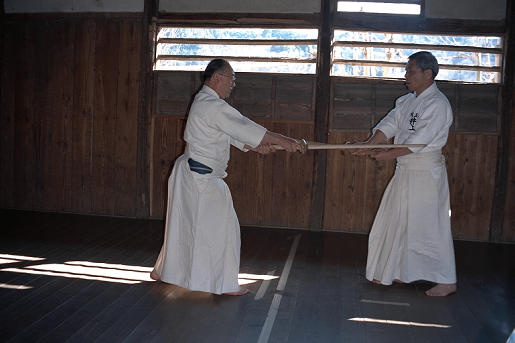Kogen Itto-ryu: An Overview
by Meik Skoss
History
Kogen Itto-ryu kenjutsu is perhaps most famous as the ryu studied by the mad swordsman in the novel and film titled Daibosatsu Toge (the English title is "Sword of Doom"). It is an amalgamation of the household martial traditions of the Henmi family and Mizoguchi-ha Itto-ryu. Kogen Itto-ryu was founded by Henmi Tashiro Yoshitoshi, a descendant of a branch of the Takeda family, who are themselves descended from the Emperor Seiwa through Minamoto no Tsunemoto and Shinrasaburo Minamoto no Yoshimitsu (also in the lineage of Daito-ryu aikijujutsu). The name of the ryu is derived by combining the first character of Kai province, where the Takeda family lived (in present-day Yamanashi Prefecture; the character is pronounced "ko"), with that of their ancestral family (Minamoto is one of the most prestigious names to have in one's lineage; pronounced "gen"), and an acknowledgment of the Itto-ryu's contribution to this school of swordsmanship.
Kogen Itto-ryu developed as a discrete style of kenjutsu when an exponent of the Aizu Mizoguchi-ha Itto-ryu, Sakurai Gosuke Nagamasa, came to the Chichibu area (present-day Saitama Prefecture) and taught Henmi Yoshitoshi the techniques of his style. Sakurai came to acknowledge the technical superiority of his erstwhile student by later becoming a disciple of the Kogen Itto-ryu, accepting Henmi as his teacher. He stayed with the Henmi family for years, was cared for by them in his old age, and is buried in the Henmi family cemetery near their home.
The Henmi family was well known as a family of strong swordsmen, but they were not retainers of a particular lord and did not serve or live in a joka machi (castle town). The family farmed its own land and taught people who came to the area for instruction. Students generally trained in the morning and evening, and worked in the fields during the afternoon, trading their labor for tuition.
The dojo is in a typical old-style nagaya (long building) to the front of their house, where the Henmis established the Yobukan Dojo, which became famous throughout the province. Farming equipment is kept in a number of small storage rooms on the left as one goes through the gate; the dojo is to the right.

Entrance to the Yobukan Dojo at the Henmi family home in Saitama Prefecture.
The current dojo was built more than two hundred years ago by the founder and is not a terribly large space, perhaps fifteen meters long and five meters wide. An old kago (palanquin) is kept up in the rafters. Old farming equipment (some of it for silkworm cultivation) is also stored there. A large door leads in from the earthen courtyard. As one looks toward the "front" of the dojo, there is a small raised shihan shitsu (room for the teachers) off to the left, covered with straw mats; in that room is an image of Marishiten, to which members of the dojo bow at the beginning and end of training. A couple of spears and naginata, used for special demonstrations, are kept over the door of the shihan shitsu; otherwise, trainees bring their own equipment with them and nothing is left at the dojo. Currently, Henmi Chifuji serves as the ninth headmaster of the ryu.
Technical Characteristics
There are twenty-five sword techniques in Kogen Itto-ryu and five naginata waza, which were introduced from the Toda-ha Buko-ryu. That may not seem like a very large technical repertoire, but the content of the techniques is so well conceived and executed that any more would be extraneous.
Although the iaijutsu techniques are no longer practiced, their names remain in the mokuroku and deserve mention, because of their unusual nature. Unlike any other ryu that I've seen, the iai techniques are referred to by the various kuji (literally, "nine characters," derived from esoteric Buddhism, used by koryu in various ways to instill particular mental states that are useful in combat and in training). Each of the characters is associated with a particular Buddhist worthy, but detailed information about the techniques is not available. Most current members of the Kogen Itto-ryu are skilled exponents of Muso Shinden-ryu iaido and kendo, as well as the classical techniques; some also have backgrounds in jojutsu or other modern unarmed arts.
Kogen Itto-ryu technique is very spare, with an economy of movement and a very strict sense of "line" and "timing." It has no superfluous content, although the meaning or utility of some movements is not immediately apparent. The reiho (formal etiquette) of the ryu is also fairly unique and seems to be a development of the mid-Edo period in that a tachiainin (observer) lays out the weapons and stays in attendance throughout the performance of techniques, a holdover from dueling etiquette (according to what a senior instructor told me).

Shidachi, right, has deflected uchidachi's thrust and counterattacked to uchidachi's left wrist and midsection.
Another holdover from the past is the presence of a number of Kogen Itto-ryu dojo throughout the area of what used to be called Musashi Province. Licensed instructors of the ryu taught in their own dojo and, over the years, different lines of teaching developed, leading to several minor differences in technique and even in curriculum. The headmaster of the ryu is still a member of the Henmi family and he continues to teach and train in the Yobukan Dojo; other people do the same in other parts of Saitama Prefecture. All, however, continue to maintain close contact with the Henmi family, "touching base with the source"; this has led to a remarkable vitality and a sense of camaraderie among the scattered students that will likely ensure that Kogen Itto-ryu will remain a vital part of their respective communities.

Contact Koryu.com
Last modified on January 4, 2018
URL: https://koryu.com /library/mskoss14.html
Copyright ©2022 Koryu Books. All rights reserved.
